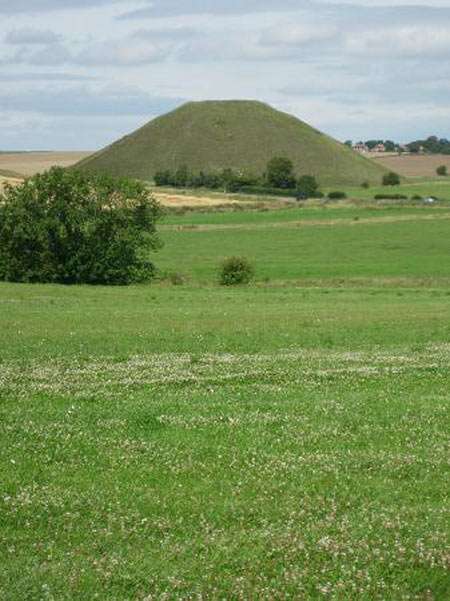

|
Some megalithic sites have healing properties. Over the years I have heard a few anecdotes in this regards. It happened to me once, totally unexpected, when I visited Avebury in Southern England. Silbury Hill, part of the complex of Neolithic monuments around Avebury in Wiltshire (which includes the nearby West Kennet long barrow), is the tallest prehistoric man-made mound in Europe, and one of the world’s largest. It is approximately 130 feet (40 m.) high, with a circular base circumference of 1640 feet. It is composed of over 12 million cubic feet (339,600 cubic m.) of chalk and earth and covers over 5 acres (2 ha). The mound consists of thousands of chalk bricks forming walls enclosing terraced infill at three levels. The next phase comprised the building of six concentric steps or terraces of chalk which were then covered with chalk rubble, flint, gravel, and finally soil to form a cone-shaped mound. Each of the six steps was concealed within the overall profile of the mound, except the last one at the top which was left as a terrace or ledge about 17 feet (5 m.) below the summit. The mound was then graded with chalk to give an angle which is coincidentally the same as the pyramids at Giza. Quartz crystals have been found in the surface soil. |
|
Recent seismological research on Silbury Hill (undertaken because of fear that old excavations had weakened the structure) has revealed a spiral path to the top – rather than the stepped cone previously accepted. It seems likely that this was a processional ‘maze’ – a pattern to be walked in ritual observance. The same survey has also revealed a radial sub-structure, suggesting that it would have had a web-like appearance. Geophysical and ground surveys of Silbury show it was built in a spiral, and not made from a series of flat layers as previously thought.
According to Avebury researcher Michael Dames, Silbury is, in effect, an earth-sculpture of the pregnant Great Goddess, a fertility symbol par excellence. He has also traced the form of a ‘composite goddess’ in the landscape around Avebury, with prehistoric monuments emphasizing the natural features comprising the figure. |

|
In 1992 I went (for the second time) to Glastonbury. I desperately wanted to go back to Silbury Hill. The year before I had joined a group of four other people for a ancient site tour in Southern England. We visited Silbury Hill, took a couple of pictures, and went on to visit nearby West Kennet Long Barrow. But Silbury Hill kept hanging on in my mind. The following year I went back by myself. I was staying at Glastonbury. By luck I met an American couple who were driving to Avebury one day. As public transportation to Avebury was very cumbersome, I took the opportunity to join the couple. While they visited the stone circles at Avebury, I went for the twenty minute walk, through the fields, to Silbury Hill. I have to mention that since I had arrived at Glastonbury a sore throat had developed that was worsening by the day. As I climbed Silbury Hill my throat was very bad. It was mid September and the colder weather was not doing me any good. When I reached the top, I laid down for fifteen minutes in the center of the flattened top. I wanted to feel the energy of hill, as Silbury Hill is supposed to be a major energy vortex. But I did not feel anything special. Little did I know that I was lying on top of a wooden platform that was covering a vertical shaft dug by the Duke of Northumberland, decades earlier. After his failure to find any tomb or treasures he had capped the shaft with a timber raft which had then been covered by chalk. On May 29, 2000 the raft collapsed. Since I had about two hours to spend there, I went to the edge of the top facing the direction of West Kennet Long Barrow, sat down and watched the landscape. As it was the second half of September, all the wheat fields had been harvested, and any traces of crop circles had disappeared. The wind was blowing hard creating many dust devils, swirling around the fields, crossing hedges and continuing in the neighboring fields. It was quite a spectacle. With the top of the hill about 130 feet (40 m.) above the surface, it was quite windy up there, but each time the sun broke through the clouds, it would be so warm that I had to take off my jacket. When the sun disappeared I had to put it back on again to protect myself against the cold wind. Not really good for my sore throat, but I enjoyed myself up there watching the landscape and the play of the elements of nature. Two hours passed. When I went down the path again, I noticed that my sore throat had completely vanished. This was, and still is, a most amazing thing to me. Whenever I get sore throats in the winter, they get worse, often developing into colds, and they last at least two weeks. Here on Silbury Hill it was completely cured in two hours! That convinced me that The energy on Silbury Hill is very healing, aside from any other properties it might have. I have not found much information about people’s experiences with Silbury Hill. Dowsers have found that it lies on the St Michael’s ley line. Some people have seen lights above the hill at night, and every year crop circles form in the wheat fields around it. |